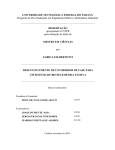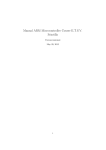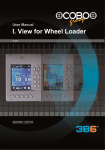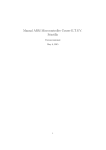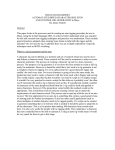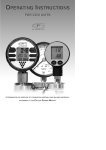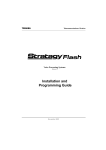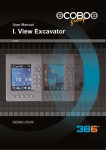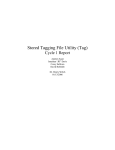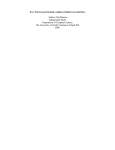Download PTSS2003 Module and Test Board User`s Manual August 2003
Transcript
PTSS2003 Module and Test Board User’s Manual August 2003 Pegasus Technologies, Inc 254 Babbs Road Lenoir City, TN 37771 (865) 483-7748 (Ph) (775) 261-0914 (Fx) [email protected] IMPORTANT NOTICE Pegasus Technologies, Incorporated and its subsidiaries (Pegasus) reserve the right to make changes to their products or to discontinue any product or service without notice, and advise customers to obtain the latest version of relevant information to verify, before placing orders, that information being relied on is current and complete. All products are sold subject to the terms and conditions of sale supplied at the time of order acknowledgment, including those pertaining to warranty, patent infringement, and limitation of liability. Pegasus warrants performance of its products to the specifications applicable at the time of sale in accordance with Pegasus’s standard warranty. Testing and other quality control techniques are utilized to the extent Pegasus deems necessary to support this warranty. Specific testing of all parameters of each device is not necessarily performed, except those mandated by government requirements. Customers are responsible for their applications using Pegasus components. In order to minimize risks associated with the customer’s applications, adequate design and operating safeguards must be provided by the customer to minimize inherent or procedural hazards. Pegasus assumes no liability for applications assistance or customer product design. Pegasus does not warrant or represent that any license, either express or implied, is granted under any patent right, copyright, mask work right, or other intellectual property right of Pegasus covering or relating to any combination, machine, or process in which such products or services might be or are used. Pegasus’s publication of information regarding any third party’s products or services does not constitute Pegasus’s approval, warranty or endorsement thereof. By using this product, the customer agrees to these terms. Copyright 2003, Pegasus Technologies, Incorporated i Table of Contents Hardware Overview ........................................................................................................ 1 PTSS2003 Module ...................................................................................................... 1 PTSS2003 Test Board ................................................................................................. 1 Supporting Software........................................................................................................ 2 Networking ..................................................................................................................... 3 Overview .................................................................................................................... 3 Examples .................................................................................................................... 4 RF Communication Requirements................................................................................... 7 Power Up Modes............................................................................................................. 8 Standard PU Modes..................................................................................................... 9 Advanced PU Modes................................................................................................. 10 Range Testing ............................................................................................................... 12 Transparent Mode ......................................................................................................... 14 Serial Communication................................................................................................... 15 Serial Packet Communication.................................................................................... 15 Serial Packet Structure .............................................................................................. 15 Serial Command Groups ........................................................................................... 15 Standard Configuration ............................................................................................. 17 Data .......................................................................................................................... 25 Packet ....................................................................................................................... 26 Status ........................................................................................................................ 32 Custom...................................................................................................................... 36 FCC Information........................................................................................................... 37 iii Hardware Overview PTSS2003 Module The PTSS2003 module is basically a hardware device used for transmitting serial data over an RF link. It can communicate at several RF and serial baud rates. A block diagram of the module is shown in Figure 1. Figure 1: PTSS2003 Module Block Diagram PTSS2003 Test Board The PTSS2003 test board provides a mechanism for communicating with the PTSS2003 module via a standard RS232 link. The test board connects directly to a host system and has and antenna connector and status LED’s. 1 Supporting Software Currently, the PTSS2003 is supported through a console application (PTSS2003TR), which allows access to the majority of the functionality of the PTSS2003 module to be demonstrated and tested. The console application can be run on Windows 9x machines and required that the module be connected to a RS232 serial port through the PTSS2003 Test Board or compatible hardware. 2 Networking Overview There are several networking options with the PTSS2003 module. Each module has a configurable network group, ID, and custom code. As implied, the network group can be used to configure a common group of PTSS2003 modules to communicate amongst themselves, ignoring messages from other groups. The network ID is the individual PTSS2003 module’s network address within the group. There is a specific group and ID that are reserved for group broadcasts. If a network group of ‘0’ is used in the transmit message, all PTSS2003 modules will listen to the message, regardless of their group ID. If a broadcast among a specific group is required, the transmit message should contain the desired group with a network ID of ‘0’. As additional protection, there is a network custom code. All received packets must contain the same custom code as code as programmed on the module, regardless if there is a group broadcasts. There are 4 main types of transmitted packets: Encoded/Response, Encoded, No Response, Not Encoded/Response, Not Encoded/No Response. In response messages (auto reply), the transmitter sends a data packet and waits on a response. For broadcasting, response messages are not allowed. Similarly, if a module transmits outside of it’s group, response messages are not allowed as the responding module will respond within it’s own group. 3 Examples In the following example, there are 3 different groups. A diagram of the network is shown in Figure 2. Figure 2: Network Example Internal Group Communication All internal group communication requires that the network group be set to the same group as the transmitting device. For example, if module G1.A wanted to communicate with module G1.B, the network group of the transmit packet should be 185 and the network ID should be set to the corresponding network ID of G1.B. In another example, if module G1.C wanted to send an internal group broadcast message, the network group of the transmit packet should be 185 and the network ID should be 0. With the exception of internal group broadcasts, all internal group communication can auto reply. 4 External Group Communication It is possible for a group to communicate with a member of another group as long as the proper network group and ID are used. However, it will not be possible for the member of that group to auto reply. For example, if module G1.A wanted to communicate with module G2.B, the network group of the transmit packet should be 200 and the network ID should be set to the corresponding ID of G2.B. Since the custom code is different, groups 1 and 2 will always ignore messages from group 3 and vice versa. 5 RF Communication Requirements In order for a transmitter and receiver to communicate with one another, the following conditions must be met: • Same RF baud rate and deviation, • Same hop table (i.e., same hop table seed), • Same network custom code, • Same network group or network group of zero, and • Rx network ID or network ID of zero. In order for a transmitter and receive to transmit an auto reply packet, the previous conditions must be met in addition to the following conditions: • Transmission must be to a specific network ID within the transmitters network group, • Transmission network group cannot be zero, and • Target receiver network ID cannot be zero. 7 Power Up Modes There are several specialty modes that the PTSS2003 can enter at power up. These modes are set through the standard power-up (PU) control and parameter (serial command 12) and the advanced PU control and parameter (serial command 66) commands. The standard PU mode contains the following functions: • Change the serial message response mode, • Wake or sleep at PU, • Range Transmit or Receive at PU, and • Receive at PU. The advanced PU mode contains the following functions: • Receive on specific channel at PU, • Transmit a square wave on a specific channel at PU, and • Transmit non-modulated data on a specific channel at PU. In nearly all cases, the advanced PU mode will never be used and may void the FCC certification if used incorrectly. Therefore, these commands are locked so that they cannot be accidentally enabled. 8 Standard PU Modes As mentioned previously, the standard PU modes are enabled through the serial interface. Most of the standard PU modes are mutually exclusive. For example, the range test transmit or receive mode cannot operate with the receive at PU mode. As soon as the serial response is received, the selected power up mode immediately begins operating. The standard PU mode serial command data packet contains a 16-bit word. Specific bits in the standard PU mode word indicate the power up mode. Table 1: Standard PU Modes Standard PU Control 7 (LSB) 6 Bit # 15 (MSB) 14 Byte 0 (LSB) Byte 1 (MSB) RX (LSB) (MSB) RM2 5 (LSB) 13 (MSB) 4 (LSB) 12 (MSB) 3 (LSB) 11 (MSB) RM1 RM0 Wake 2 (LSB) 10 (MSB) 1 9 (LSB) (MSB) 0 8 (LSB) (MSB) Range Range Range RX TX AL Unused Unused Unused Unused Unused Unused Unused TM Bits 8 7 6-4 Function Transparent Mode Receive at PU Response Mode 3 Wake at PU 2 1 0 Range Rx at PU Range Tx at PU Range Activity Level Description The module goes into transparent mode after initialization. The module goes into receive mode after initialization. Type of serial response when a packet is received. The following modes are valid: 0b000 RM0 – R0 Packet (HL+DL+NG+NID+Data+RXPARAM) 0b001 RM1 – R1 Packet (HL+DL+NG+NID+Data) 0b010 RM2 – R2 Packet (HL+DL+NG+NID) 0b011 RM3 – R3 Packet (HL+DL) 0b100 RM4 – R3 Packet (HL+DL) The module stays awake after initialization at opposed to going to sleep and having to be awakened. The module goes into range test receive mode. The module goes into range test transmit mode. Activity level of the range indicator. 9 Advanced PU Modes As mentioned previously, the advanced PU modes are enabled through the serial interface. All of the advanced PU modes are mutually exclusive. The advanced PU mode serial command data packet contains two bytes of data. The first byte is the advanced PU control. The second byte is the advanced PU parameter, which indicates the channel in the hop table on which to transmit or receive. Specific bits in the advanced PU mode byte indicate the power up mode. Table 2: Advanced PU Modes Advanced PU Control MSB (Bit 7) RSV7 Linear Tx Tx Rx Range NMOD Square on Hop Single Channel on on Table Freq Channel Channel RX Bits 7 6 Function Reserved Linear Hop Table 5 Transmit Non Modulated Data on Specified Channel Transmit Square Wave Data on Specified Channel Receive Data on Specified Channel 4 3 2 1 0 Range Single Frequency Rx at PU Range Single Frequency Tx at PU Range Single Frequency Activity Level Range Single Freq TX LSB (Bit 0) Range Single Freq AL Description Not Used When enabled, the hop table is initialized with 50 channels evenly spaced from 903 MHz to 927 MHz. Otherwise, the hop table is generated in the normal manner. The module turns on transmitter for the specified channel after initialization but does not transmit any data. The module turns on transmitter for the specified channel after initialization and continuously transmits a square wave pulse (0b10101010). The module turns on receiver for the specified channel after initialization. However, the receive data is not processed. The module goes into range test single frequency receive mode. The module goes into range test single frequency transmit mode. Activity level of the range indicator. 10 Advanced PU Parameter MSB (Bit 7) CH7 CH6 CH5 Bits 7-0 Function Channel CH4 CH3 CH2 CH1 LSB (Bit 0) CH0 Description Specified channel in the hop table on which to transmit or receive. There are 50 channels in the hop table. If transmission on the lowest frequency (903 MHz), middle frequency (915 MHz), or upper frequency (927 MHz) is desired, the advanced PU parameter should be loaded with 0xFD, 0xFE, and 0xFF, respectively. 11 Range Testing The PTSS2003 module has built in range test capability. The host system can set up modules to be a transmitter or receiver and the activity level of the indication LEDs. This configuration will remain in effect until it is disabled by the host system. The transmitter will send packets approximately every 300 milliseconds. This message is broadcast to network group 0, network id 0. Just as in normal operation, the network custom code should be the same in the transmitter and receiver. Table 3 shows the PTSS2003 output pins used by the range transmitter test and Table 4 shows the PTSS2003 output pins used by the range transmitter test. The activity level indicates the active level of the outputs. If the activity level is 1, a pin will assert a 1 when the indicated condition occurs and default back to 0 at the end of the condition. If the activity level is 0, a pin will assert a 0 when the indicated condition occurs and default back to 1 at the end of the condition. Table 3: Range Test Transmitter Pin Assignments Range Test Transmitter Pin Assignments Description Tx/Rx Line: Indicates whether the module is configured as a transmitter or receiver where 0==receiver and 1==transmitter (Activity Level Low) OR 1==receiver and 0==transmitter (Activity Level High) Packet Transmitted: Indicates when a packet was transmitted where 0==packet transmitted (Activity Level Low) OR 1==packet transmitted (Activity Level High) PTSS2003 Module J1.8 PTSS2003 Test Board P2.0 J1.7 P2.1 12 Table 4: Range Test Receiver Pin Assignments Range Test Receiver Pin Assignments Description Tx/Rx Line: Indicates whether the module is configured as a transmitter or receiver where 0==receiver and 1==transmitter (Activity Level Low) OR 1==receiver and 0==transmitter (Activity Level High) Packet Received: Indicates when a packet was received where 0==packet transmitted (Activity Level Low) OR 1==packet transmitted (Activity Level High) RSSI Range 0 () where 0==RSSI within Range 0 (Activity Level Low) OR 1==RSSI within Range 0 (Activity Level High) RSSI Range 1 () where 0==RSSI within Range 1 (Activity Level Low) OR 1==RSSI within Range 1 (Activity Level High) RSSI Range 2 () where 0==RSSI within Range 2 (Activity Level Low) OR 1==RSSI within Range 2 (Activity Level High) RSSI Range 3 () where 0==RSSI within Range 3 (Activity Level Low) OR 1==RSSI within Range 3 (Activity Level High) RSSI Not Measured where 0==RSSI not measured (Activity Level Low) OR 1==RSSI not measured (Activity Level High) PTSS2003 Module J1.8 PTSS2003 Test Board P2.0 J1.7 P2.1 J1.6 P2.2 J1.5 P2.3 J1.4 P2.4 J1.3 P2.5 J1.2 P2.6 13 Transparent Mode The PTSS2003 module has a special mode that allows data written to the serial port to be automatically loaded and transmitted without the use of loading the buffer and instructing the module to transmit. This mode, transparent mode, is good in situations where the user wants to transmit data from a source which is outputting serial data packets (such as a GPS receiver) and does not want to create a packet, load the buffer, and send the data. However, there are some downfalls to this mode of operation. The user will receive no RF status data (such as RSSI). Also, this mode does not transmit auto reply packets; therefore there is no way of the transmitter knowing if the packet was received. In order to exit transparent mode, the ASCII escape sequence of “+++” should be used. If this escape sequence unsuitable for the application, please contact Pegasus for a custom firmware package. The transparent mode module can be setup to transmit packets to a specific module or all modules within it’s group. Packets are transmitted based upon a character delay of 10 characters based upon the baud rate. If no new characters are received or if 80 characters have been written to the module, the module will automatically transmit the packet. The character delays are shown in Table 5. Table 5: Transparent Mode Transmit Delay Serial Baud Rate (bits per second) Bit Time (seconds) Byte Time* (seconds) 1200 0.00083300 2400 0.00041700 4800 0.00020800 9600 0.00010400 19200 0.00005210 38400 0.00002600 57600 0.00001740 115200 0.00000868 * Includes Start and Stop Bits for a Total of 10 Bits 0.0083330 0.0041670 0.0020830 0.0010420 0.0005210 0.0002600 0.0001740 0.0000868 Transmit Delay (seconds) 0.083333 0.041667 0.020833 0.010417 0.005208 0.002604 0.001736 0.000868 14 Serial Communication Serial Packet Communication The serial interface on the PTSS2003 module is relatively simple. The default baud rate is 38400 with no parity, 8 data bits, and a stop bit. However, the baud rate can be changed through the serial interface. Since there is no flow control, the only required serial signals are Rx and Tx. Essentially, the host system sends a command and the PTSS2003 module processes the command and replies. All commands will receive a reply to let the host system know that the indicated operation was performed. Figure 3 shows the basic communication flow between the host and the PTSS2003 module. Figure 3: Host-PTSS2003 Communication Serial Packet Structure The serial packets are variable length, where the first two bytes are the length of the packet (packet length parameter). Many commands are fixed length, and therefore the length is easy to determine. However, other packets (such as the data packets), are quite often not the same length. Care should be taken to ensure that the packet length parameter is the proper value. If the packet length parameter is too small, the entire received data packet will not be processed. Consequently, if the packet length parameter is too large, the serial interface will wait until it receives the total number of bytes indicated by the packet length and the serial interface will appear to hang. The next byte of the packet is the command ID. In a response message, the following byte is the command error code. In situations where the packet parameters are the more than one byte in length, the parameters should be loaded from LSB to MSB. Serial Command Groups There are several commands that the host can send to the module. The commands are grouped based upon functionality. These groups are shown in Table 6. 15 Table 6: Serial Command Groups Command Group Standard Configuration Advanced Configuration Data Packet Status Custom Description Configuration of the PTSS2003: • Writing the hop seed, • Reading the hop table, • Changing the RF baud rate, • Changing the RF deviation, • Stopping all RF activity, • Reading the board information, • Placing the PTSS2003 in sleep mode, • Waking the PTSS2003 from sleep mode, • Changing the network group, • Changing the network ID, • Changing the network custom code, • Changing the standard PU mode, • Changing the serial baud rate, and • Enabling transparent mode. Advanced Configuration of the PTSS2003: • Unlocking the advanced configuration commands, • Writing and reading the XE1202 registers, • Calculating the frequency adjustment, • Turning on the transmitter and receiver on the first channel (903 MHz), middle channel (915 MHz), last channel (927 MHz), or a specified channel, • Starting a flash program sequence, • Writing or reading a flash program segment, • Turning on the transmitter for frequency adjustment, • Transmitting modulated data on the first channel (903 MHz), middle channel (915 MHz), last channel (927 MHz), or a specified channel, • Transmitting square wave data on the first channel (903 MHz), middle channel (915 MHz), last channel (927 MHz), or a specified channel, and • Changing the advanced PU mode. Read and Write Packet Data Controls Transmission and Reception of Packets Status of the PTSS2003: • Last channel information and • Last Rx RSSI Value. • Read and Write the Time Custom Commands Developed By Pegasus for a Custom Application 16 Standard Configuration Write Hop Seed (1) Description This command writes the 16-Bit hop seed. The hop seed, RF baud rate, and RF deviation are used to randomly select the 50 channels that will be used in data transmission and reception. On the PTSS2003 module, there are 50 available channels. Command 5 0 1 P1 P1 Parameters à P1 (U16): 16-Bit Hop Seed Response 6 0 1 EC P1 Parameters à EC (U8) : Error Code P1 (U16): New Hop Seed 0 à Operation OK All Others Invalid Error Code P1 Read Hop Table (2) Description Command Response Error Code This command reads the hop table. 3 0 2 Parameters à None 104 0 2 EC C1 C1 … C50 C50 Parameters à EC (U8) : Error Code CX (S16): Hop Table Channel. Values should be multiplied by 500 and then added to 915000000 to get the channel frequency. 0 à Operation OK All Others Invalid 17 Change the RF Baud Rate (3) Description This command changes the RF baud rate. When the RF baud rate is changed, the RF deviation is automatically changed to the optimal value for the new RF baud rate. Command 4 0 3 P1 Parameters à P1 (U8) : Baud Rate Selection where 0 == 4.8 kb/s; 1 == 9.6 kb/s; 2 == 19.2 kb/s; 3 == 38.4 kb/s; 4 == 76.8 kb/s and all others invalid. Response 5 0 3 EC P1 Parameters à EC (U8) : Error Code P1 (U8) : New Baud Rate 0 à Operation OK 1 à Baud Rate Out of Range All Others Invalid Error Code Change the RF Deviation (4) Description This command changes the RF deviation. The RF deviation can never be less than the RF baud rate. For example, if a RF baud rate of 19.2 kb/s is selected, the RF deviation cannot be 5 or 10 kHz. In this instance, the RF deviation will not be changed and will return an error code of 2. Command 4 0 4 P1 Parameters à P1 (U8) : Deviation Selection where 0 == 5 kHz; 1 == 10 kHz; 2 == 20 kHz; 3 == 40 kHz; 4 == 100 kHz and all others invalid. Response 5 0 4 EC P1 Parameters à EC (U8) : Error Code P1 (U8) : New Deviation 0 à Operation OK 1 à Deviation Out of Range 2 à Deviation Less Than Baud Rate All Others Invalid Error Code 18 Stop All RF Activity (5) Description Command Response Error Code This command stops all RF activity (Receive or Transmit). 3 0 5 Parameters à None 4 0 5 EC Parameters à EC (U8) : Error Code 0 à Operation OK All Others Invalid 19 Read the Board Information (6) Description Command This command reads the board information. Response 50 0 6 EC P1 P1 P1 P2 P3 P3 P3 P3 P4 P4 P5 P5 P6 P6 P6 P6 P7 P8 P9 P10 P11 P11 P12 P12 P15 P15 P16 P17 P18 P19 Parameters à EC (U8) : Error Code P1 (U32) : Software Revision P2 (U32) : Software Revision Code P3 (U32) : Hardware Revision P4 (U32) : Hardware Revision Code P5 (U32) : Serial Number Prefix P6 (U32) : Serial Number P7 (U32) : Calibration Frequency P8 (U16) : Hop Seed P9 (U8) : RF Baud Rate P10 (U8) : RF Deviation P11 (U16): Network Group P12 (U16): Network ID P13 (U16): Network Custom Code P14 (U16): Standard PU Control P15 (U16): Transparent Mode Transmit ID P16 (U8) : Advanced PU Control P17 (U8) : Advanced PU Parameter P18 (U8) : Serial Baud Rate P19 (U8) : Hop Table Channels 0 à Operation OK All Others Invalid Error Code 3 0 6 Parameters à None P1 P4 P7 P13 P2 P4 P7 P13 P2 P5 P7 P14 P2 P5 P8 P14 20 Put the Board in Sleep Mode (7) Description Command This command places the board in sleep mode. Response 4 0 7 EC Parameters à EC (U8) : Error Code 0 à Operation OK All Others Invalid Error Code 3 0 7 Parameters à None Wake the Board from Sleep Mode (8) Description This command wakes the board from sleep mode. If the board is in sleep mode, the board will not reply with a response. Command 3 0 8 Parameters à None Response 4 0 8 EC Parameters à EC (U8) : Error Code 0 à Operation OK All Others Invalid Error Code 21 Change the Network Group (9) Description Command This command changes the network group. Response 6 0 9 EC P1 P1 Parameters à EC (U8) : Error Code P1 (U16): New Network Group 0 à Operation OK All Others Invalid Error Code 5 0 9 P1 P1 Parameters à P1 (U16): 16-Bit Network Group Change the Network ID (10) Description Command This command changes the network ID. Response 6 0 10 EC P1 P1 Parameters à EC (U8) : Error Code P1 (U16): New Network ID 0 à Operation OK All Others Invalid Error Code 5 0 10 P1 P1 Parameters à P1 (U16): 16-Bit Network ID Change the Network Custom Code (11) Description Command This command changes the network custom code. Response 6 0 11 EC P1 P1 Parameters à EC (U8) : Error Code P1 (U16): New Network Custom Code 0 à Operation OK All Others Invalid Error Code 5 0 11 P1 P1 Parameters à P1 (U16): 16-Bit Network Custom Code 22 Standard PU Mode (12) Description This command changes the standard PU mode. For a detailed description of the standard PU mode, refer to the “Standard PU Modes” of the “Power Up Modes” Section (page 9). Command 7 0 12 P1 P1 P2 P2 Parameters à P1 (U16): Standard PU Control P2 (U16): Transparent Mode Tx Network ID Response 8 0 12 EC P1 P1 P2 P2 Parameters à EC (U8) : Error Code P1 (U16): New Standard PU Control P2 (U16): New Transparent Mode Tx Network ID 0 à Operation OK 1 à Advanced Power Up Mode Active 2 à Rx Mode, Range Tx, Range Rx, and Transparent Mode are mutually exclusive All Others Invalid Error Code Serial Baud Rate (13) Description This command changes the serial baud rate. The module will respond at the old baud rate before switching to the new baud rate. Command 4 0 13 P1 Parameters à P1 (U8) : Serial Baud Rate where 0 == 9600 bps, 1 == 19200 bps, 2 == 38400 bps, 3 == 57600 bps, 4 == 115200 bps and all others invalid. Response 5 0 13 EC P1 Parameters à EC (U8) : Error Code P1 (U8) : New Serial Baud Rate 0 à Operation OK All Others Invalid Error Code 23 Enable Transparent Mode (14) Description Command This command enables transparent mode. Response 6 0 13 EC P1 P1 Parameters à EC (U8) : Error Code P1 (U8) : New Transparent Mode Transmit ID 0 à Operation OK All Others Invalid Error Code 4 0 14 P1 P1 Parameters à P1 (U16): Transparent Mode Transmit ID. 24 Data Write Data to the Transmit Buffer (81) Description Command This command writes data to the transmit buffer. Response 4 0 81 EC Parameters à EC (U8) : Error Code 0 à Operation OK All Others Invalid Error Code X+7 81 P1 P1 Parameters à P1 (U16): Buffer Address P2 (U16): Length DX (U8): Buffer Data P2 P2 D1 … DX Read Data from the Transmit Buffer (82) Description Command This command reads data from the transmit buffer. 7 0 82 P1 P1 Parameters à P1 (U16): Buffer Address P2 (U16): Length P2 P2 Response X+4 82 EC D1 Parameters à EC (U8) : Error Code DX (U8): Buffer Data 0 à Operation OK All Others Invalid … DX Error Code Read Data from the Receive Buffer (83) Description Command This command reads data from the transmit buffer. 7 0 83 P1 P1 Parameters à P1 (U16): Buffer Address P2 (U16): Length P2 P2 Response X+4 83 EC D1 Parameters à EC (U8) : Error Code DX (U8): Buffer Data 0 à Operation OK All Others Invalid … DX Error Code 25 Packet Transmit Packet (Encoded/Response) (121) Description Command This command transmits an encoded packet listens for a response. Response 4 0 121 EC Parameters à EC (U8) : Error Code 0 à Operation OK 1 à Length Cannot be Zero 2 à No Response Received 3 à Response Not Allowed on External Group Broadcast 4 à Response Not Allowed on Internal Group Broadcast 5 à Response Not Allowed on External Group Board Communication 6 à Cannot Transmit more than 128 bytes at 4800 bps (FCC) All Others Invalid Error Code 10 0 121 P1 P2 P2 P3 P3 P4 P4 Parameters à P1 (U8) : Use different network group where 1 == use specified network group and all others are use stored network group P2 (U16): Length P3 (U16): Network Group P4 (U16): Network ID 26 Transmit Packet (Encoded/No Response) (122) Description Command This command transmits an encoded packet. Response 4 0 122 EC Parameters à EC (U8) : Error Code 0 à Operation OK 1 à Length Cannot be Zero 2 à No Response Received 3 à Response Not Allowed on External Group Broadcast 4 à Response Not Allowed on Internal Group Broadcast 5 à Response Not Allowed on External Group Board Communication All Others Invalid Error Code 10 0 122 P1 P2 P2 P3 P3 P4 P4 Parameters à P1 (U8) : Use different network group where 1 == use specified network group and all others are use stored network group P2 (U16): Length P3 (U16): Network Group P4 (U16): Network ID 27 Transmit Packet (Response) (123) Description Command This command transmits a packet and listens for a response. Response 4 0 123 EC Parameters à EC (U8) : Error Code 0 à Operation OK 1 à Length Cannot be Zero 2 à No Response Received 3 à Response Not Allowed on External Group Broadcast 4 à Response Not Allowed on Internal Group Broadcast 5 à Response Not Allowed on External Group Board Communication All Others Invalid Error Code 10 0 123 P1 P2 P2 P3 P3 P4 P4 Parameters à P1 (U8) : Use different network group where 1 == use specified network group and all others are use stored network group P2 (U16): Length P3 (U16): Network Group P4 (U16): Network ID 28 Transmit Packet (No Response) (124) Description Command This command transmits a packet. Response 4 0 124 EC Parameters à EC (U8) : Error Code 0 à Operation OK 1 à Length Cannot be Zero 2 à No Response Received 3 à Response Not Allowed on External Group Broadcast 4 à Response Not Allowed on Internal Group Broadcast 5 à Response Not Allowed on External Group Board Communication All Others Invalid Error Code 10 0 124 P1 P2 P2 P3 P3 P4 P4 Parameters à P1 (U8) : Use different network group where 1 == use specified network group and all others are use stored network group P2 (U16): Length P3 (U16): Network Group P4 (U16): Network ID 29 Receive Packet (125) Description Command This command receives a packet. Response 4 0 125 EC Parameters à EC (U8) : Error Code 0 à Operation OK All Others Invalid Error Code 3 0 125 Parameters à None 30 Receive Packet Acknowledge (126) Description This command acknowledges that a packet has been received. The acknowledgement message is dependent upon the response mode in the standard PU mode setup. For a detailed description of the standard PU mode, refer to the “Standard PU Modes” of the “Power Up Modes” Section (page 9). Command 3 0 126 Parameters à None Response L+8 126 EC P10 P10 P20 P20 P31 P31 P41 P41 D12 … DX2 P53 P63 P63 P73 Parameters à L (U16): Length Dependent Upon Response Mode where Response Mode 4 or 3, L==0; Response Mode 2, L==4; Response Mode 1, L==X+4; and Response Mode 0, L==X+8; EC (U8) : Error Code P1 (U16): Receive Buffer Address P2 (U16): Data Length P3 (U16): Rx Network Group P4 (U16): Rx Network ID DX (U8): Buffer Data P5 (U8): Last Rx Channel P6 (S16): Last Rx Frequency. Values should be multiplied by 500 and then added to 915000000 to get the channel frequency. P7 (U8): Last Rx RSSI. The most significant bit of this byte is the range of the where 0b1?????? is Range 1 (R1) and 0b0?????? is Range 0 (R0). The least significant 2 bits (0b?????xx) indicates the RSSI value where 0== (<-105 dB [R0]) or (<-90 dB [R1]), 1== (-105 dB to -100 dB [R0]) or (-90 dB to -85 dB [R1]), 2== (-100 dB to -95 dB [R0]) or (-85 dB to -80 dB [R1]), and 3== (>-95 dB [R0]) or (>-85 dB [R1]). Notes: 0 Response Modes 3,2,1,0 1 Response Modes 2,1,0 2 Response Modes 1,0 3 Response Mode 0 0 à Operation OK All Others Invalid Error Code 31 Status Read the Last Transmit and Receive Channels (161) Description This command reads the last channel index and channel number of the last successful transmit and receive packet. Command 3 0 161 Parameters à None Response 10 0 161 EC P1 P2 P2 P3 P4 P4 Parameters à EC (U8) : Error Code P1 (U8) : Last Tx Channel P2 (S16): Last Tx Frequency. Values should be multiplied by 500 and then added to 915000000 to get the channel frequency. P3 (U8) : Last Rx Channel P4 (S16): Last Rx Frequency. Values should be multiplied by 500 and then added to 915000000 to get the channel frequency. 0 à Operation OK All Others Invalid Error Code Read the Last Rx RSSI Level (162) Description This command reads the last RSSI level of the last successful receive packet. Command 3 0 162 Parameters à None Response 5 0 162 EC P1 Parameters à EC (U8) : Error Code P1 (U8): Last Rx RSSI. The most significant bit of this byte is the range of the where 0b1?????? is Range 1 (R1) and 0b0?????? is Range 0 (R0). The least significant 2 bits (0b?????xx) indicates the RSSI value where 0== (<-105 dB [R0]) or (<-90 dB [R1]), 1== (-105 dB to -100 dB [R0]) or (-90 dB to -85 dB [R1]), 2== (-100 dB to -95 dB [R0]) or (-85 dB to -80 dB [R1]), and 3== (>-95 dB [R0]) or (>-85 dB [R1]) 0 à Operation OK All Others Invalid Error Code 32 Read the Temperature and Battery Voltage (163) Description Command This command reads the temperature and battery voltage. Response 8 0 163 EC P1 P1 P2 Parameters à EC (U8) : Error Code P1 (U16): Temperature in °C P2 (U16): Battery Voltage in milliVolts 0 à Operation OK All Others Invalid Error Code 3 0 163 Parameters à None P2 33 Set the Time (164) Description This command sets the module time. The date and time are checked to ensure that they are valid. Command 11 0 164 P1 P1 P2 P3 Parameters à P1 (U16): Year P2 (U8) : Month (1-12) P3 (U8) : Day (1-31) P4 (U8) : Hour (0-23) P5 (U8) : Minute (0-59) P6 (U8) : Second (0-59) P7 (U8) : Use Daylight Savings Time Response 15 0 164 EC P1 P1 P2 P3 P4 P5 P6 P7 P8 P9 P9 Parameters à EC (U8) : Error Code P1 (U16): Year P2 (U8) : Month P3 (U8) : Day P4 (U8) : Hour P5 (U8) : Minute P6 (U8) : Second P7 (U8) : Daylight Savings Time where bit0 is currently DST and bit1 is DST enabled. P8 (U8) : Week Day P9 (U16): Year Day 0 à Operation OK 1 à Invalid Month 2 à Invalid Day 3 à Invalid Hour 4 à Invalid Minute 5 à Invalid Second All Others Invalid Error Code P4 P5 P6 P7 34 Read the Time (165) Description Command Response Error Code This command reads the module time. 3 0 165 Parameters à None 15 0 165 EC P1 P1 P2 P3 P4 P5 P6 P7 P8 P9 P9 Parameters à EC (U8) : Error Code P1 (U16): Year P2 (U8) : Month P3 (U8) : Day P4 (U8) : Hour P5 (U8) : Minute P6 (U8) : Second P7 (U8) : Daylight Savings Time where bit0 is currently DST and bit1 is DST enabled. P8 (U8) : Week Day P9 (U16): Year Day 0 à Operation OK All Others Invalid 35 Custom Pegasus can write custom commands for the PTSS2003 module. Similarly, depending upon the application, the PTSS2003 module can be modified to work without any serial interface to make the entire system design self confined to the PTSS2003 module. There are resources for items such as touch pad scanning and analog sampling. Contact Pegasus for information on PTSS2003 customization. 36 FCC Information RF Transceiver Installation Instructions The PTSS2003 Transceiver Frequency Hopping Spread Spectrum transceiver. This transceiver should only be installed by qualified service personnel. The transceiver detects level, low battery or other data signals from the external binary inputs and broadcasts that data to the system's host receiver. MOUNTING LOCATION The PTSS2003 Transceiver is a module as defined by the FCC and therefore must be mounted to another host device in order to function. This device is intended only for OEM integrators under the following conditions: 1) The integrator must position this device in any end product such that the antenna to user/bystander distance is greater than 20 cm when the transmitter is functioning (excluding hands, wrists, feet and ankles). 2) The transmitter module may not be co-located with any other transmitter or antenna. As long as the 2 conditions above are met, further transmitter testing will not be required. However, the OEM integrator is still responsible for testing their end-product for any additional compliance requirements required with this module installed (for example, digital device emissions, PC peripheral requirements, etc.). IMPORTANT NOTE: In the event that these conditions can not be met (for example applications where the antenna to user distance is < 20 cm or to be co-located with another transmitter), then the original FCC authorization is no longer considered valid and the FCC ID can not be used on the final product. In these circumstances, the OEM integrator will be responsible for re-evaluating the end product (including the transmitter) and obtaining a separate FCC authorization. NOTICE TO CUSTOMER Any Pegasus Technologies customer incorporating the PTSS2003 transceiver module into its own product must have an external notice affixed to its product. This notice must be placed in a conspicuous location and can use wording such as: “Contains FCC ID: QLBPTSS2003” or “Contains Transceiver Module FCC ID: QLBPTSS2003”. Any similar wording that expresses the same meaning may be used. NOTE: The end user should NOT be provided any instructions on how to remove or install the device. RF Exposure Manual Information That Must be Included to End User The users manual for end users must include the following information in a prominent location "IMPORTANT NOTE: To comply with FCC RF exposure compliance requirements, the antenna used for this transmitter must be installed to provide a 37 separation distance of at least 20 cm from all persons and must not be co-located or operating in conjunction with any other antenna or transmitter." INSTALLATION INSTRUCTIONS 1. Supply the transceiver with DC power by inserting a 3.6 Volt battery into the battery holder on the customers host application circuit board. 2. The unit will come pre-programmed with a Network ID and Hop Seed. However, the customer does have the option of field programming the unit. 3. If possible, avoid installing the PTSS2003 in areas near large metallic objects such as air conditioners, heaters, screens and heaters. CAUTION: This device is required to comply with FCC RF exposure requirements for mobile and fixed transmitting devices. The FCC requires that the antenna used for this transmitter must be installed to provide a separation of at least 20 cm (8 inches) from all persons (not including hands, wrists, feet, and ankles) and must not be co-located or operating in conjunction with any other antenna or transmitter. FCC NOTICE The Model PTSS2003 transceiver generates and uses radio frequency energy. If not installed and used in accordance with the manufacturer's instructions, it may cause interference to radio and television reception. The transceiver has been tested and found to comply with the specifications in Part 15 of FCC Rules for Spread Spectrum Intentional Radiators and FCC Part 15 Subpart C, Specifications. If this equipment causes interference to radio or television reception - which can be determined by turning the equipment on and off - the installer is encouraged to correct the interference by one or more of the following measures: 1) Reorient the antenna of the radio/television. 2) Connect the AC transformer to a different outlet so the control panel and radio/television are on different branch circuits. 3) Relocate the control panel with respect to the radio/television. If necessary, the installer should consult an experienced radio/television technician for additional suggestions, or send for the "Interference Handbook" prepared by the Federal Communications Commission. This booklet is available from the U.S. Government Printing Office, Washington, D.C., 20402, stock number 004-000-00450-7. CAUTION: No field changes or modifications to the PTSS2003 should be made unless they are specifically covered in this manual. All adjustments must be made at the factory under the specific guidelines set forth in our manufacturing processes. Any modification to the equipment could void the user's 38 authority to operate the equipment and render the equipment in violation of FCC Part 15, Subpart C, 15.247. This device complies with Part 15 of the FCC Rules. Operation is subject to the following two conditions: (1) this device may not cause harmful interference, and (2) this device must accept any interference received, including interference that may cause undesired operation. LIMITED WARRANTY THERE ARE NOT WARRANTIES, EXPRESS OR IMPLIED, OF MERCHANTABILITY OR FITNESS FOR A PARTICULAR PURPOSE OR OTHERWISE, WHICH EXTEND BEYOND THE DESCRIPTION ON THE FACE HEREOF. In no case shall Seller be liable to anyone for any consequential or incidental damages for breach of this or any other warranty, express or implied, or upon any other basis of liability whatsoever, even if the loss or damage is caused by Seller's own negligence or fault. 39











































